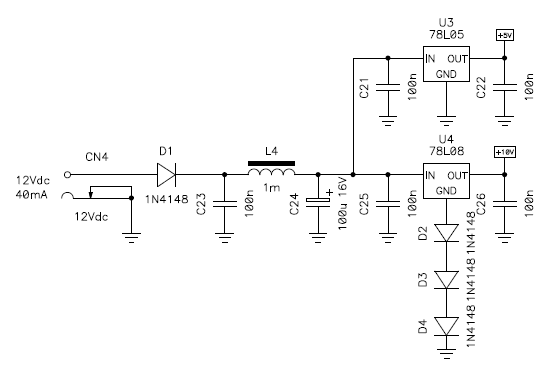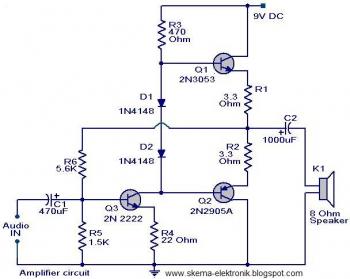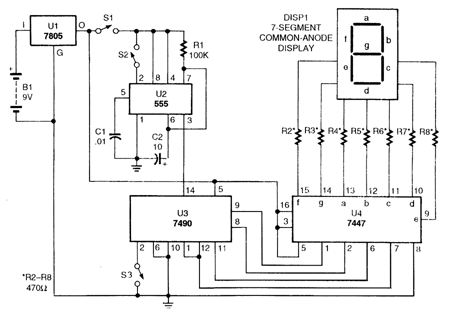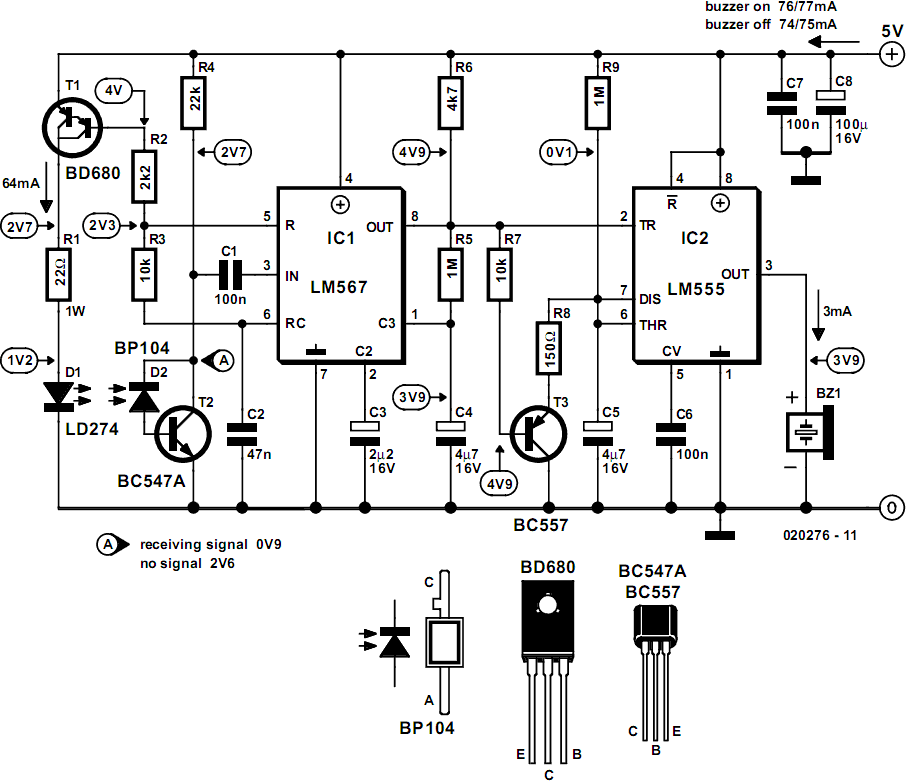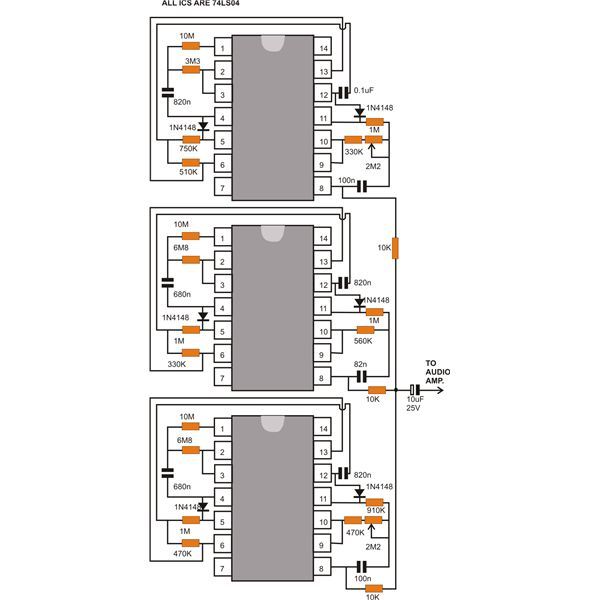
Simple Metal Detector
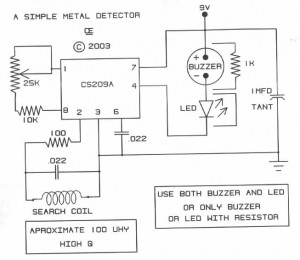
The diagram illustrates a simple and efficient receiver designed for activating garage doors, starter motors, alarms, warning systems, and various other applications. The SCR utilized in this circuit features an extremely low trigger current of 30 µA, requiring only 30 µW of input power to activate the relay. Additionally, the design includes a high Q tuned FM tracking transmitter. The circuit, created by Tony van Roon, is accompanied by an FM tracking transmitter diagram.
Component List:
- R1 = 10K
- C1 = 100 µF/10V
- C2 = 10 nF
- C3 = 4-40 pF trimmer capacitor
- C4 = 4.7 pF
- IC1 = LM3909
- Q1 = 2N3904 NPN transistor
- LED1 = Red LED or any preferred color
This design represents a high-quality FM transmitter suitable for stereo systems or other amplifiers, capable of delivering a strong signal up to a distance of 500 meters with a power output of approximately 200 mW. The circuit operates on a 9V battery, with the audio frequency modulation stage closely associated with the BF494 transistor (T1).
Furthermore, the schematic details a stereo tube amplifier circuit utilizing 6SQ7-GT and 6V6-GT vacuum tubes. This tube amplifier configuration incorporates a total of five power vacuum tubes, inspired by the output section design of a typical late 1940s AM Trutone radio, producing an output of 4 Watts per channel (2x4W).
Additionally, a cell phone shield circuit is presented, which functions as a mobile charger while providing protection against unauthorized use or theft. This circuit is designed to emit a loud chirping sound if an attempt is made to remove the mobile handset.
Lastly, a 1.5 Watt FM transmitter circuit is described, which can cover a range of 1-2 kilometers. The component list for this circuit includes:
- R1 = 220K
- R2 = 4.7K
- R3, R4 = 10K
- R5 = 100 ohm
- C1, C2 = 4.7 µF Electrolytic
- C3, C4 = 1 nF
- C5 = 2-15 pF
- C6 = 3.3 pF
- Q1 = BC547C
- Q2 = 2N2219A
- P1 = 25K (acting as a condenser microphone volume control)
- MIC = Electret Condenser Type
For FM transmission, a small coil is recommended, constructed from thin gauge enamel magnet wire.Above diagram is a very easy and efficient receiver for actuating garage doors, starter motors, alarms, warning systems and many some other possibilities. The SCR, which has a extremely low trigger current of 30 uA is typical - it demands an input electricity of just 30 uW to activate the relay.
A high Q tuned. Easy FM tracking transmitter proje ct :). The circuit designed by Tony van Roon, and here the FM tracking transmitter diagram: Components List: R1 = 10K C1 = 100uF/10V C2 = 10nF C3 = 4-40pF trimmer capacitor C4 = 4. 7pF IC1 = LM3909 Q1 = 2N3904 NPN transistor LED1 = Red LED/or another color as you. This the Good Quality FM transmitter for your stereo or any other amplifier gives you a pretty good signal strength up to a range of 500 metres having a power output of about 200 mW.
This circuit can be operated with a 9V battery. The audio-frequency modulation stage is constructed close to transistor BF494 (T1), . This is the circuit diagram of stereo tube amplifier using 6SQ7-GT and 6V6-GT. The tube amplifier circuit is uses the total of 5 power vacuum tube. The diagram is based on the output section design of typical late 1940`s old AM Trutone radio with 6 tubes. The output will be 4 Watts per channel (2x4W. This is the cell phone shield circuit which can be used as mobile charger. Give protection to your cell phone from unexpected use or theft working with this easy circuit. It is able to produce a loud chirping sound when someone tries to take away the mobile handset. The added function is that the circuit. This is 1. 5 Watt FM Transmitter circuit. This circuit should be able to cover 1-2 KM range. Components List R1=220K R2=4. 7K R3, R4=10K R5=100ohm C1, C2=4. 7uF Electrolytic C3, C4=1nF C5=2-15pF C6=3. 3pF Q1=BC547C Q2=2N2219A P1=25K MIC=Electret Condenser Type P1 act as condenser microphone volume level.
For FM, coil will be small. Use thin gauge enamel magnet wire. the diameter. 🔗 External reference
Component List:
- R1 = 10K
- C1 = 100 µF/10V
- C2 = 10 nF
- C3 = 4-40 pF trimmer capacitor
- C4 = 4.7 pF
- IC1 = LM3909
- Q1 = 2N3904 NPN transistor
- LED1 = Red LED or any preferred color
This design represents a high-quality FM transmitter suitable for stereo systems or other amplifiers, capable of delivering a strong signal up to a distance of 500 meters with a power output of approximately 200 mW. The circuit operates on a 9V battery, with the audio frequency modulation stage closely associated with the BF494 transistor (T1).
Furthermore, the schematic details a stereo tube amplifier circuit utilizing 6SQ7-GT and 6V6-GT vacuum tubes. This tube amplifier configuration incorporates a total of five power vacuum tubes, inspired by the output section design of a typical late 1940s AM Trutone radio, producing an output of 4 Watts per channel (2x4W).
Additionally, a cell phone shield circuit is presented, which functions as a mobile charger while providing protection against unauthorized use or theft. This circuit is designed to emit a loud chirping sound if an attempt is made to remove the mobile handset.
Lastly, a 1.5 Watt FM transmitter circuit is described, which can cover a range of 1-2 kilometers. The component list for this circuit includes:
- R1 = 220K
- R2 = 4.7K
- R3, R4 = 10K
- R5 = 100 ohm
- C1, C2 = 4.7 µF Electrolytic
- C3, C4 = 1 nF
- C5 = 2-15 pF
- C6 = 3.3 pF
- Q1 = BC547C
- Q2 = 2N2219A
- P1 = 25K (acting as a condenser microphone volume control)
- MIC = Electret Condenser Type
For FM transmission, a small coil is recommended, constructed from thin gauge enamel magnet wire.Above diagram is a very easy and efficient receiver for actuating garage doors, starter motors, alarms, warning systems and many some other possibilities. The SCR, which has a extremely low trigger current of 30 uA is typical - it demands an input electricity of just 30 uW to activate the relay.
A high Q tuned. Easy FM tracking transmitter proje ct :). The circuit designed by Tony van Roon, and here the FM tracking transmitter diagram: Components List: R1 = 10K C1 = 100uF/10V C2 = 10nF C3 = 4-40pF trimmer capacitor C4 = 4. 7pF IC1 = LM3909 Q1 = 2N3904 NPN transistor LED1 = Red LED/or another color as you. This the Good Quality FM transmitter for your stereo or any other amplifier gives you a pretty good signal strength up to a range of 500 metres having a power output of about 200 mW.
This circuit can be operated with a 9V battery. The audio-frequency modulation stage is constructed close to transistor BF494 (T1), . This is the circuit diagram of stereo tube amplifier using 6SQ7-GT and 6V6-GT. The tube amplifier circuit is uses the total of 5 power vacuum tube. The diagram is based on the output section design of typical late 1940`s old AM Trutone radio with 6 tubes. The output will be 4 Watts per channel (2x4W. This is the cell phone shield circuit which can be used as mobile charger. Give protection to your cell phone from unexpected use or theft working with this easy circuit. It is able to produce a loud chirping sound when someone tries to take away the mobile handset. The added function is that the circuit. This is 1. 5 Watt FM Transmitter circuit. This circuit should be able to cover 1-2 KM range. Components List R1=220K R2=4. 7K R3, R4=10K R5=100ohm C1, C2=4. 7uF Electrolytic C3, C4=1nF C5=2-15pF C6=3. 3pF Q1=BC547C Q2=2N2219A P1=25K MIC=Electret Condenser Type P1 act as condenser microphone volume level.
For FM, coil will be small. Use thin gauge enamel magnet wire. the diameter. 🔗 External reference
